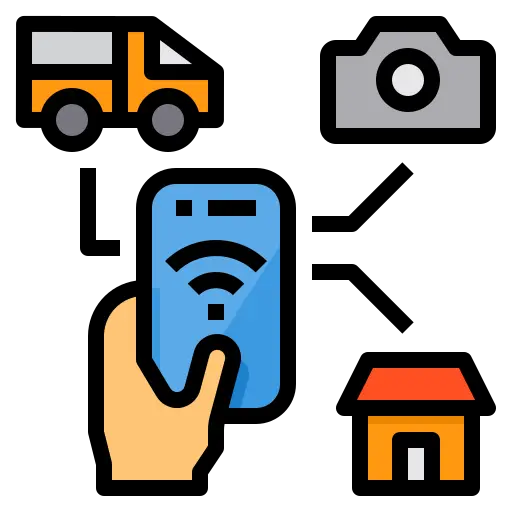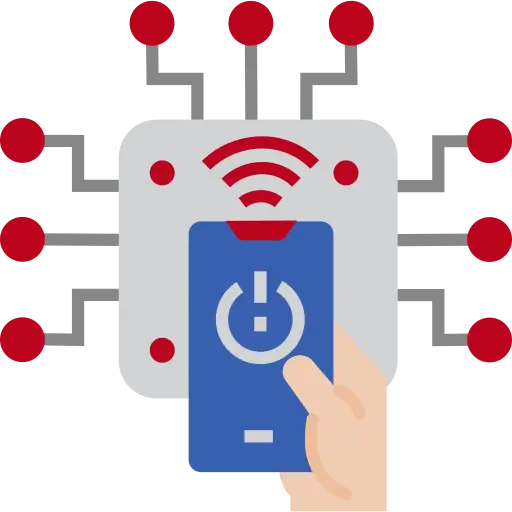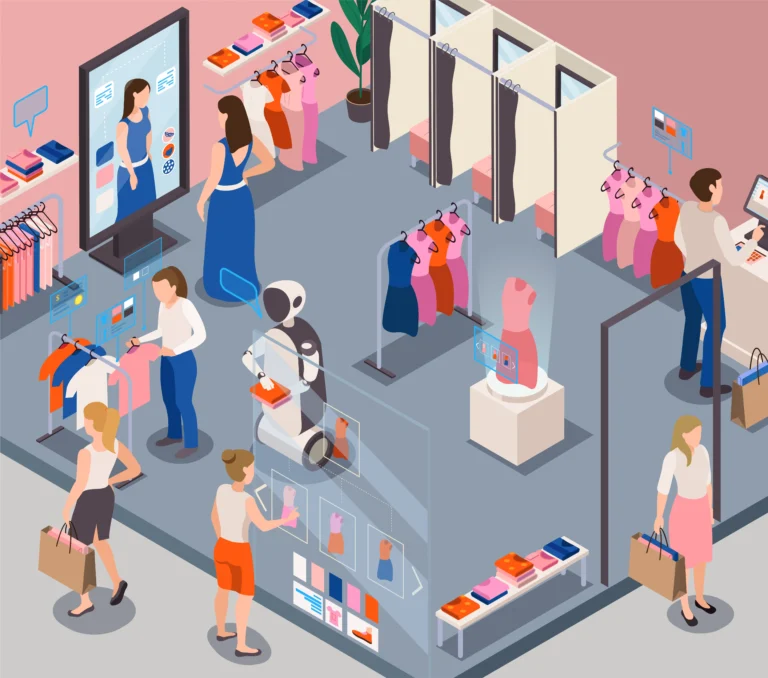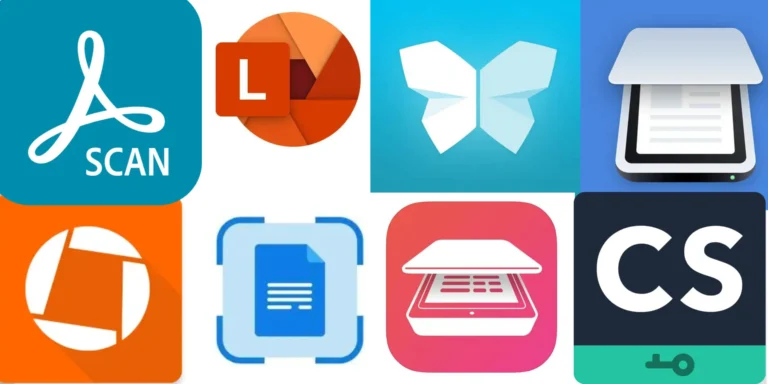AI: 10 Ways the IoT is Transforming Industries
The Internet of Things (IoT) refers to the network of physical devices, vehicles, buildings, and other objects that are embedded with sensors, software, and connectivity, allowing them to collect and exchange data. These devices are connected to the internet and can communicate with each other, as well as with other systems and devices.

The IoT is an important topic because it has the potential to transform a wide range of industries and applications. It is already being used in a variety of ways, such as to improve the efficiency and sustainability of manufacturing, retail, healthcare, agriculture, energy, transportation, education, government, real estate, and environmental conservation. The IoT is also being used to create new forms of value for customers, such as by providing personalized experiences and enabling new forms of collaboration and communication.
As the IoT continues to grow and evolve, it is likely to have a significant impact on society and the way we live and work. As such, it is an important topic for discussion and exploration.
Manufacturing
The IoT allows manufacturers to track and monitor their production processes in real time, allowing them to identify bottlenecks and inefficiencies. By gathering and analyzing data from sensors and other connected devices, manufacturers can optimize their processes to reduce waste and increase efficiency.

For example, using IoT-enabled equipment, manufacturers can monitor the performance of their machines and identify when maintenance is needed, reducing costly downtime. They can also track the use of raw materials and adjust their production processes accordingly to reduce waste.
In addition, the IoT can help manufacturers improve the supply chain by providing real-time visibility into inventory levels and delivery times, allowing them to adjust their production schedules to meet customer demand.
Overall, the IoT has the potential to greatly improve the efficiency and sustainability of the manufacturing industry.
Example of Manufacturing IoT
- Monitoring equipment performance: IoT-enabled sensors and devices can be used to monitor the performance of manufacturing equipment in real-time. This allows manufacturers to identify problems early on and schedule maintenance before equipment breaks down, reducing costly downtime.
- Tracking the use of raw materials: By gathering data from sensors and other connected devices, manufacturers can track the use of raw materials in their production processes and adjust their processes to reduce waste.
- Optimizing the supply chain: The IoT can provide real-time visibility into inventory levels and delivery times, allowing manufacturers to adjust their production schedules to meet customer demand and reduce the risk of running out of stock.
- Predictive maintenance: By analyzing data from sensors and other connected devices, manufacturers can predict when equipment is likely to fail and schedule maintenance accordingly, reducing the risk of unplanned downtime.
- Quality control: The IoT can be used to monitor the quality of products during the manufacturing process and identify issues early on, reducing the risk of defects and improving the overall quality of the final product.
Retail
The IoT is changing the way retailers interact with their customers by providing them with personalized, real-time information and recommendations. For example, retailers can use IoT-enabled devices, such as beacons, to send location-based promotions and offers to customers’ phones as they shop. They can also use IoT-enabled kiosks or displays to provide customers with product information and recommendations based on their previous purchases.

In addition, the IoT is helping retailers to better manage their inventory by providing real-time visibility into stock levels and sales data. This allows retailers to quickly reorder products and reduce the risk of running out of stock. It also allows them to better forecast demand and adjust their ordering and stocking accordingly.
Overall, the IoT is helping retailers to improve the shopping experience for customers and increase their own efficiency and profitability.
Example of Retail IoT
- Personalized promotions and offers: Retailers can use IoT-enabled devices, such as beacons, to send location-based promotions and offers to customers’ phones as they shop. This can help to increase sales and customer satisfaction.
- Product recommendations: Retailers can use IoT-enabled kiosks or displays to provide customers with product information and recommendations based on their previous purchases. This can help to increase sales and customer loyalty.
- Inventory management: The IoT can provide real-time visibility into stock levels and sales data, allowing retailers to quickly reorder products and reduce the risk of running out of stock. It can also help retailers to better forecast demand and adjust their ordering and stocking accordingly.
- Supply chain management: The IoT can be used to track the movement of goods from the manufacturer to the retailer, providing real-time visibility into the supply chain and allowing retailers to adjust their ordering and stocking as needed.
- Customer service: Retailers can use the IoT to provide personalized customer service, such as by using connected devices to track customer preferences and tailor recommendations accordingly.
Healthcare
The IoT is being used in a variety of ways to improve patient care and outcomes in the healthcare industry. Some examples include:

- Remote monitoring: IoT-enabled devices, such as wearable sensors and smart pills, can be used to remotely monitor patients’ vital signs and provide real-time data to healthcare providers. This allows for early detection of potential problems and can prevent the need for hospitalization.
- Electronic health records: The IoT is helping to improve the accuracy and efficiency of electronic health records (EHRs) by providing real-time updates and enabling the exchange of information between healthcare providers.
- Clinical decision support: The IoT is being used to provide healthcare providers with real-time, evidence-based recommendations for treatment and care, improving the accuracy and effectiveness of care.
- Drug delivery: IoT-enabled devices can be used to precisely control the delivery of drugs to patients, improving treatment outcomes and reducing the risk of side effects.
- Telemedicine: The IoT is enabling telemedicine, which allows patients to connect with healthcare providers remotely, improving access to care and reducing the need for in-person visits.
Overall, the IoT is helping to improve the quality and efficiency of healthcare by providing real-time data and enabling the exchange of information between healthcare providers.
Agriculture
The IoT is being used in a variety of ways to improve the efficiency and sustainability of the agriculture industry. Some examples include:

- Precision agriculture: IoT-enabled sensors and devices can be used to monitor soil conditions, weather patterns, and crop health in real time, allowing farmers to optimize irrigation, fertilization, and pest control. This can help to increase crop yields and reduce the use of resources such as water and pesticides.
- Livestock monitoring: The IoT can be used to monitor the health and behavior of livestock, allowing farmers to identify and address problems early on. This can improve the well-being of the animals and increase the efficiency of livestock production.
- Supply chain management: The IoT can be used to track the movement of agricultural products from the farm to the consumer, allowing for more efficient and sustainable supply chain management.
- Weather prediction: The IoT can be used to improve the accuracy of weather predictions, which can help farmers to better plan for planting and harvesting.
- Water management: The IoT can be used to optimize the use of water in agriculture, such as by monitoring soil moisture levels and adjusting irrigation accordingly.
Overall, the IoT is helping to increase the efficiency and sustainability of the agriculture industry by providing real-time data and enabling the optimization of resources.
Energy
The IoT is being used in a variety of ways to optimize energy usage and improve efficiency in the energy industry. Some examples include:

- Smart grid: The IoT is being used to create a “smart grid” that can monitor and optimize the distribution of electricity from power plants to consumers. This can help to reduce waste and improve the efficiency of the energy system as a whole.
- Energy management: IoT-enabled devices, such as smart thermostats and appliances, can be used to monitor and control energy usage in buildings and homes. This can help to reduce energy consumption and lower energy bills.
- Renewable energy: The IoT is being used to monitor and optimize the performance of renewable energy sources, such as wind turbines and solar panels. This can help to increase the efficiency and reliability of these sources.
- Predictive maintenance: The IoT can be used to predict when energy infrastructure, such as power lines and transformers, is likely to fail and schedule maintenance accordingly, reducing the risk of unplanned outages.
- Energy conservation: The IoT can be used to promote energy conservation by providing real-time data on energy usage and enabling the automation of energy-saving measures.
Overall, the IoT is helping to improve the efficiency and sustainability of the energy industry by providing real-time data and enabling the optimization of energy usage.
Transportation
The IoT is being used in a variety of ways to revolutionize the way we move, both in terms of personal transportation and logistics. Some examples include:

- Connected cars: The IoT is being used to create “connected” cars that can communicate with other vehicles and systems, such as traffic lights and road signs. This can improve safety and efficiency on the roads.
- Autonomous vehicles: The IoT is enabling the development of autonomous vehicles, such as self-driving cars and drones, which can move goods and people without the need for human intervention.
- Smart transportation systems: The IoT is being used to create smart transportation systems that can optimize the movement of people and goods, such as by monitoring traffic patterns and adjusting routes accordingly.
- Public transportation: The IoT is being used to improve the efficiency and convenience of public transportation, such as by providing real-time information on bus and train schedules and enabling the automation of ticketing and payment.
- Logistics: The IoT is being used to optimize the movement of goods, such as by providing real-time visibility into the supply chain and enabling the automation of shipping and delivery.
Overall, the IoT is helping to revolutionize the way we move by improving the efficiency and convenience of transportation and logistics.
Education
The IoT is being used in a variety of ways to enhance the educational experience for students. Some examples include:

- Personalized learning: The IoT is being used to create personalized learning experiences for students, using data from sensors and other connected devices to adapt the learning experience to the individual needs and preferences of each student.
- Collaborative learning: The IoT is being used to enable collaborative learning, allowing students to connect and work together in real-time, regardless of location.
- Virtual and augmented reality: The IoT is being used to create immersive educational experiences using virtual and augmented reality. This can make learning more engaging and interactive for students.
- Remote learning: The IoT is enabling remote learning, allowing students to access educational resources and connect with teachers and classmates from anywhere.
- Interactive classrooms: The IoT is being used to create interactive classrooms that can adapt to the needs and learning styles of individual students. This can be achieved through the use of connected devices, such as tablets and smartboards, that can provide personalized content and feedback.
Overall, the IoT is helping to enhance the educational experience for students by providing real-time data and enabling personalized, collaborative, and immersive learning experiences.
Government
The IoT is being used in a variety of ways to improve government services and increase transparency. Some examples include:

- Infrastructure management: The IoT can be used to monitor and optimize the performance of government infrastructure, such as roads, bridges, and buildings. This can help to reduce maintenance costs and improve the efficiency of government operations.
- Environmental monitoring: The IoT can be used to monitor and protect the environment, such as by providing real-time data on air and water quality and enabling the automation of waste management.
- Disaster response: The IoT can be used to improve disaster response by providing real-time data on the location and needs of affected areas and enabling the automation of rescue and relief efforts.
- Elections: The IoT can be used to enhance the security and transparency of elections, such as by using connected devices to track voter turnout and enable online voting.
- Public health: The IoT can be used to improve public health, such as by providing real-time monitoring of disease outbreaks and enabling the automation of vaccination campaigns.
Overall, the IoT is helping to improve government services and increase transparency by providing real-time data and enabling the delivery of services online.
Real estate
The IoT is being used in a variety of ways to change the way we think about buildings and urban planning. Some examples include:

- Smart buildings: The IoT is being used to create “smart” buildings that can optimize the use of resources, such as energy and water, and improve the quality of life for residents. This can be achieved through the use of connected devices, such as smart thermostats and appliances, that can monitor and control various building systems.
- Building management: The IoT is being used to improve the management of buildings, such as by providing real-time monitoring of maintenance needs and enabling the automation of various building systems.
- Urban planning: The IoT is being used to inform urban planning decisions, such as by providing real-time data on traffic patterns and enabling the optimization of public transportation routes.
- Real estate marketing: The IoT is being used to enhance the marketing of real estate, such as by providing virtual tours and enabling the creation of interactive 3D models of properties.
- Smart cities: The IoT is being used to create smart cities, which can optimize the use of resources and improve the quality of life for citizens. This can be achieved through the use of connected devices, such as sensors and cameras, that can monitor and control various city systems.
Overall, the IoT is changing the way we think about buildings and urban planning by providing real-time data and enabling the optimization of resources.
Environmental conservation
The IoT is being used in a variety of ways to monitor and protect the environment. Some examples include:

- Environmental monitoring: The IoT is being used to monitor various environmental factors, such as air and water quality, wildlife populations, and weather patterns. This can help to identify environmental issues and inform conservation efforts.
- Natural resource management: The IoT is being used to optimize the use of natural resources, such as water and timber, and reduce waste. This can be achieved through the use of connected devices, such as sensors and drones, that can monitor resource use and provide real-time data.
- Climate change: The IoT is being used to monitor and understand the impacts of climate change, such as by providing real-time data on temperature and sea levels. This can inform efforts to mitigate and adapt to climate change.
- Pollution control: The IoT is being used to monitor and reduce pollution, such as by providing real-time data on air and water quality and enabling the automation of waste management.
- Environmental conservation: The IoT is being used to support environmental conservation efforts, such as by providing real-time data on wildlife populations and enabling the automation of conservation programs.
Overall, the IoT is helping to protect the environment by providing real-time data and enabling the optimization of resource management.
Conclusion
In conclusion, the IoT is transforming a wide range of industries, including manufacturing, retail, healthcare, agriculture, energy, transportation, education, government, real estate, and environmental conservation. It is improving efficiency, sustainability, and the quality of products and services in these industries by providing real-time data and enabling the optimization of resources.
The potential for further disruption in the future is significant. As the IoT continues to evolve and more devices and systems become connected, it is likely that it will continue to transform industries in new and unexpected ways. Some potential areas for future disruption include the integration of artificial intelligence and machine learning, the development of new business models, and the creation of new forms of value for customers.
Useful Links
- How AI Changing Healthcare In A Major Way In 2023!
- IFTTT: The Ultimate Tool for Automating Your Life in 2023
- The Future of Connected Devices: Is the Internet of Things Really Secure?
FAQ
What are examples of IoT devices?
Smart thermostats: These devices can be used to monitor and control the temperature in a home or office, often through a smartphone app.
Smart appliances: These are everyday appliances, such as washing machines and refrigerators, that can be connected to the internet and controlled remotely.
Wearable fitness trackers: These devices can be worn on the wrist or elsewhere on the body to track physical activity and vital signs, such as heart rate and sleep patterns.
Smart locks: These devices can be used to lock and unlock doors remotely, often through a smartphone app.
Smart home security systems: These systems can include a variety of connected devices, such as cameras and sensors, that can be used to monitor and protect a home.
Connected vehicles: These are vehicles, such as cars and trucks, that are equipped with internet connectivity and can communicate with other devices and systems.
Industrial control systems: These are systems that are used to monitor and control industrial processes, such as in manufacturing or energy production.
Medical devices: These are devices, such as wearable sensors and smart pills, that are used to monitor and manage patients’ health.
What is IoT in simple words?
The Internet of Things (IoT) refers to the growing network of physical objects that are equipped with sensors, software, and internet connectivity, allowing them to collect and exchange data. This data can be used to monitor and control the objects, as well as to analyze and optimize their performance. The IoT is transforming a wide range of industries, from manufacturing and transportation to healthcare and agriculture, and is expected to have a major impact on the way we live and work.
Are IoT Devices Secure?
Like any other connected device, Internet of Things (IoT) devices can potentially be vulnerable to security threats, such as cyber-attacks and data breaches. These threats can occur when IoT devices are not properly secured or when they are used to transmit sensitive data over an insecure network. To mitigate these risks, it is important to ensure that IoT devices are configured and maintained securely and that they are used in conjunction with secure networks and protocols.
This may include measures such as installing security updates and patches, using strong passwords and authentication and encrypting data transmitted over the network. Additionally, it is important to be aware of the potential risks associated with IoT devices and to take steps to protect against them, such as by using firewalls and antivirus software and being cautious about the information shared through connected devices.
How do IoT Devices Communicate?
There are a number of different ways that Internet of Things (IoT) devices can communicate, depending on the specific requirements of the application and the available infrastructure. Some common ways that IoT devices can communicate include:
Bluetooth: This is a short-range wireless technology that can be used to connect devices within a range of about 30 feet. It is commonly used for communication between devices that are in close proximity, such as between a smartphone and a smartwatch.
Wi-Fi: This is a wireless networking technology that can be used to connect devices over a local area network (LAN) or to the internet. It has a longer range than Bluetooth and is often used for communication between devices that are in the same building or on the same campus.
Cellular: This refers to the networks that are used to transmit data between mobile devices and the internet. IoT devices can use cellular networks to communicate over long distances, such as when they are out of the range of Wi-Fi or Bluetooth networks.
Radiofrequency (RF): This refers to the use of radio waves to transmit data wirelessly over a distance. RF can be used for communication between devices that are out of the range of other wireless technologies, such as over a wide area network (WAN).
Near field communication (NFC): This is a short-range wireless technology that can be used to transfer data between devices that are in close proximity, such as by tapping two devices together. It is often used for contactless payments and other applications where security is a concern.
How Do Iot Devices Get Hacked?
There are a number of ways that Internet of Things (IoT) devices can potentially be hacked or compromised. Some common vulnerabilities include:
Weak passwords: If an IoT device has a weak or default password, it may be more vulnerable to being hacked. Hackers can use tools to try to guess or crack these passwords, allowing them to gain unauthorized access to the device.
Insecure communication: If an IoT device transmits data over an insecure network or uses an unencrypted protocol, it may be more vulnerable to being hacked. Hackers can potentially intercept and decrypt this data as it is transmitted.
Outdated software: If an IoT device is running outdated software, it may be more vulnerable to being hacked. Hackers can exploit known vulnerabilities in the software to gain access to the device.
Lack of updates: If an IoT device is not regularly updated with the latest security patches and updates, it may be more vulnerable to being hacked.
Physical access: If an IoT device is physically accessible, a hacker may be able to gain access to it by tampering with the device or attaching malicious hardware.
To protect against these vulnerabilities, it is important to ensure that IoT devices are configured and maintained securely and that they are used in conjunction with secure networks and protocols. This may include measures such as using strong passwords, updating software regularly, and encrypting data transmitted over the network.
Why IoT Is Important?
The Internet of Things (IoT) is important because it has the potential to transform a wide range of industries and improve the way we live and work. Some specific reasons why the IoT is important to include:
Improved efficiency: The IoT can be used to optimize the performance of various systems, such as by providing real-time data and enabling the automation of tasks. This can help to increase efficiency and reduce waste.
Enhanced productivity: The IoT can be used to improve the productivity of individuals and organizations, such as by providing real-time data and enabling the automation of tasks.
Greater convenience: The IoT can be used to make everyday tasks more convenient, such as by providing real-time information and enabling the automation of tasks.
Increased safety: The IoT can be used to improve safety, such as by providing real-time monitoring and enabling the automation of emergency response.
Better decision-making: The IoT can provide organizations with a wealth of data that can be used to inform decision-making and improve outcomes.
New business opportunities: The IoT is creating new opportunities for businesses, such as by enabling the development of new products and services.
Improved quality of life: The IoT has the potential to improve the quality of life for individuals, such as by providing real-time information and enabling the automation of tasks.







